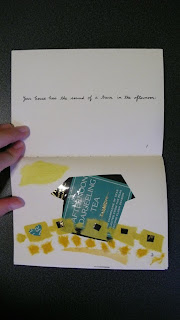After reading and illustrating several poems by Neruda, I find that apart from the brimming visual images in his works, he also resorted to all kinds of sounds and colors to construct his poetic pictures. This poem titled love sonnet XXXVIII, is a perfect example that appeals to the reader’s auditory sense. While I was illustrating for it, I couldn’t help but imagine a house in Chilean winter is warmed by an array of sounds, and thus glows.
後記:最近迷上喝英國茶,剛好把大吉嶺下午茶的茶包當作材料,作為有創意的資源回收。
PS: I have been obsessed with English tea lately, and the bags of Darjeeling afternoon tea were perfect materials for the poem. I saw this as a beautiful coincidence…
MEDIODÍA
Tu casa suena como un tren a mediodía,
Zumban las avispas, cantan las cacerolas,
la cascada enumera los hechos del rocío,
tu risa desarrolla su trino de palmera.
La luz azul del muro conversa con la piedra,
Llega como un pastor silbando un telegrama
y entre las dos higueras de voz verde
Homero sube con zapatos sigilosos.
Sólo aquí la ciudad no tiene voz ni llanto,
Ni sin fin, ni sonatas, ni labios, ni bocina
Sino un discurso de cascada y de leones,
y tú que subes, cantas, corres, caminas, bajas,
plantas, coses, cocinas, clavas, escribes, vuelves,
o te has ido y se sabe que comenzó el invierno.
午後
午後,你的房子有轟隆隆的火車聲,
大黃蜂的嗡嗡聲,砂鍋的鳴唱聲,
水滴的大合奏像瀑布一樣,
你的顫音和棕梠樹的花腔高音不相上下。
牆上蔚藍的光線和石頭喋喋不休,
它隨著哨音而來,就像送電報的牧羊人;
在營火的熊熊火焰和綠叢的聲音之間,
荷馬悄悄地向上攀登。
只有在此,城市能夠痛快地過活,
稍縱即逝,沒有號角聲、說話聲和奏鳴曲,
只有獅子和落水的對話,
同時,你在樓梯間爬上爬下,或走或跑,
唱歌、澆花、縫紉、烹飪、敲敲打打,
寫作、返回,或離去,此刻全世界說:冬天到了。

















3 comments:
今年冬天來的真晚...浪漫小少女
這二個顏色真的很討人喜歡,有穩定的活潑,另外,有個不幸的消息,我把黑金莎拿出來後,小冬瓜和Q妹整個陷入瘋狂狀態,在我出手相救前,優雅的咖啡紅已經被舔得體無完膚了....哀!
shaggy: 所以從詩裡就可以讀到啦!
小蕙:哈哈,連包裝紙都不放過,真是太可愛了啦!沒關係,我弟弟如大食怪一般,隨便幾口就幫我吃完剩下的黑金莎,我已經看到這個商品熱賣的樣子啦!
Post a Comment